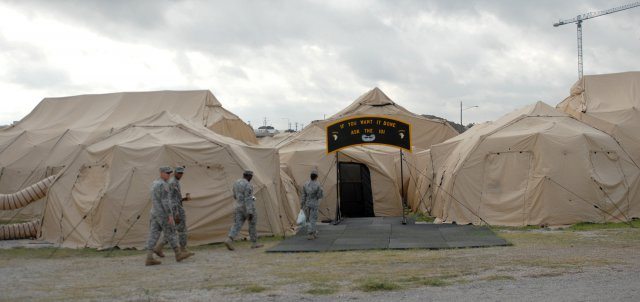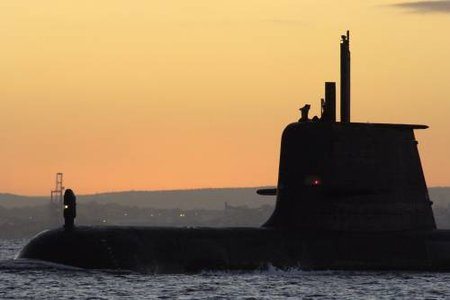More than 5,500 service members and civilians are taking part in the Army’s first corps-level, full-spectrum unified land operations training exercise in 10 years, at Fort Hood.
The III Corps Warfighter Exercise, which began June 11, is designed to exercise III Corps’ mission command functions and systems and help set the conditions for the execution of future operations.
“It ranges from anything from peacekeeping all the way to major combat operations,” said Col. Todd Buchs, III Corps operations officer. “The last ten years, we’ve been fighting counterinsurgency-centric, stability operations in Iraq and Afghanistan. Unified land operations entail fighting in those different environments simultaneously.”
Buchs said as III Corps is replicating an Army forces command for the exercise, inter-service cooperation and coordination occurs throughout the simulated scenarios.
“We’re working under a joint task force and alongside coalition forces,” he said. “This exercise has allowed us to develop ourselves as a staff to learn how to fight in a coalition environment and the complexities associated with that, but also how to fight with our joint enablers, and more importantly, fight effectively.”
The exercise scenario itself, generated by the Mission Command Training Program at Fort Leavenworth, Kan., took III Corps and its subordinate units to a fictional country which was invaded by a neighbor. Following requests for assistance, U.S. and allied forces began offensive operations to expel the simulated enemy.
Though III Corps has many veterans of previous combat tours, fighting at the corps level is new to many of them.
“It’s demanding,” said Maj. Julia Harvey, operations officer with the III Corps Engineers. “Much of my experience is at division level and below. Here, you have to quickly access the situation in order to provide your best staff estimate in support of on-going operations.”
Buchs agreed.
“There is a difference, and that’s why we do exercises like this. Many officers and noncommissioned officers spend the majority of their careers at the tactical level,” Buchs said. “That’s why it’s important to understand our doctrine. Leading up to this, we held more than 30 ‘brown-bag’ lunches and leader development programs so our staff understands how to do operations as a staff at this level.”
Harvey said that though the exercise has been demanding, the training benefit is important.
“The systems we’re using here in this simulation,” she said, “are the same ones we’d use to prosecute a real war.”
Her commanding general, Lt. Gen. Don Campbell Jr., of III Corps and Fort Hood, told Central Texas media members at a press briefing June 18 that he’s been pleased with his staff’s capabilities during the Warfighter Exercise.
“If we had to go to war tomorrow,” he said, “we’re ready.”
One division commanding general echoed that sentiment.
“The III Corps Warfighter Exercise over the last two weeks gave us a great opportunity to work with our higher headquarters and practice the art and science of mission command,” said Maj. Gen. James C. McConville, commanding general of the 101st Airborne Division out of Fort Campbell, Ky. “The exercise allowed us to refine our staff processes and improve our ability to synchronize our battlefield operating systems. Overall, it was extremely helpful in getting us ready for our next rendezvous with destiny.”
The 101st brought 149 troops to Texas from Kentucky. The division set up its tactical operation center in tents across the street from a construction site for the installation’s new hospital. While more than 5,500 troops are taking part in the exercise, it takes a small Army of role-players, evaluators and trainers to manage the on-going simulation.
“It’s very realistic,” Buchs said of the simulation scenarios his staff faces around the clock.
Col. Charles E.A. Sexton, commander of MCTP at Fort Leavenworth, is in charge of directing the exercise.
“We run about 45 different exercises each year,” he said at a press briefing June 18 in III Corps headquarters, noting that his organization trains units from brigade level and higher to prepare for their wartime missions. “This is the largest one of its kind.”
Sexton said by running this full-spectrum training exercise with III Corps, the Army is able to evaluate the changes it has made regarding personnel, logistics and doctrine over the past 10 years.
“Over the past 10 years, we’ve changed from a division-centric organization to a brigade-centric organization. We’ve changed how many people we have in units, or whether units exist anymore,” Sexton said. “We’ve made all these changes, but we’ve never had to chance to exercise them at this higher echelon, more complex environment.”
Other units, like the 504th Battlefield Surveillance Brigade, didn’t exist 10 years ago. Buchs said this exercise validates to the Army how to use units like the 504th in unified land operations, making this exercise even more important.
“This isn’t just for III Corps or the units conducting this exercise with us,” he said, “but it’s also about informing the Army about things they haven’t been informed on in the last 10 years because of the fight we’ve been in, a very specific kind of fight in Iraq and Afghanistan.”
But as with any fight, the combatants are there to win. Is III Corps winning?
“Yes, we are,” Buchs said. “But I think the real win is: did we grow as a staff? Did we inform the Army? Did we get great training value out of this? Those three things are happening, plus we’re kicking (the enemy’s) butt.”











